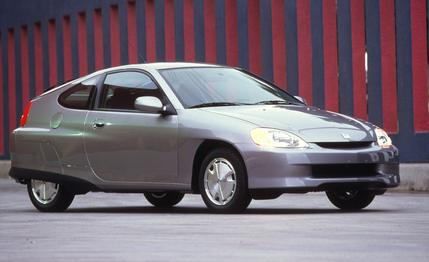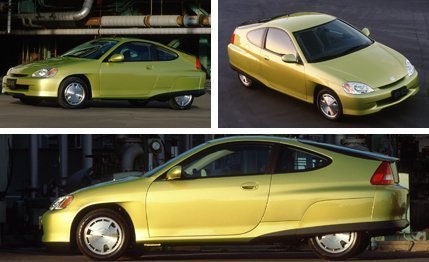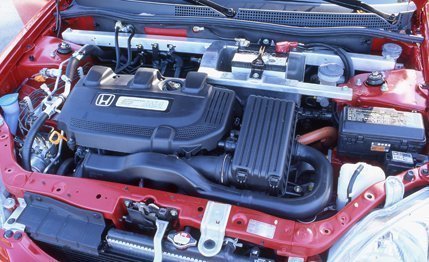 Instrumented Test
Instrumented Test
High-mileage cars are to the auto industry what art-house films are to movies. Art-house films explore the nuances of human experience through the lens of a sophisticated sensibility, but they usually do poorly at the box office due to their lack of giant exploding lizards.
In a similar vein, the new Honda Insight gas/electric hybrid is an esoteric achievement in automotive technology that few will appreciate and fewer still will buy, while mainstream American audiences fall all over themselves to see the next Godzilla-sized sport-utility vehicle.
Nonetheless, the Insight gets an Oscar in several categories. It is the cleanest (meets Ultra Low-Emission Vehicle standard and then some), most-fuel-efficient (61/70 city/highway, EPA mpg) gas-powered production vehicle in the world. The two-seat, three-door hatchback, sold here only with a five-speed manual gearbox, is also the first hybrid on the U.S. market (the Toyota Prius sedan will arrive later in 2000). And with an initial worldwide production of 8000 units—4000 of them bound annually for the U.S.—and a sticker of about $20,000, the Insight might also win the award for Least Profitable Vehicle. When asked if Honda would be selling the Insight at a loss, a company official rolled his eyes and said, "Yeah, that would be safe to assume."

The Insight could also win an award called "Most Transparent." You would expect an ecocar of this caliber to impose some tough sanctions on its drivers in terms of performance and comfort, but the Insight behaves pretty much like any conventional city car. It is comfortable and well equipped, with standard power windows and steering, remote-keyless entry, anti-lock brakes, and optional air conditioning. It can be refueled at the local Stop-and-Rob and doesn't require any external electrical charging.
In a day of driving through Washington, D.C., and over Maryland hill and dale, the Insight never felt as though it were busting a gut to keep up with traffic. Even its unique "idle stop" feature—the gas motor shuts off when the car is brought to a stop and then refires golf-cart-style when first gear is engaged—works so seamlessly that you forget it after about five minutes.
Idle stop is a feature of the Insight's Integrated Motor Assist (IMA) system. The heart of the IMA is a 10-kilowatt electric motor sandwiched between the engine and transmission. About the size of a deli pie box, the 22-pound e-motor produces 13 horsepower and 36 pound-feet of torque. This augments the three-cylinder's 67 hp and 66 lb-ft, but because the peaks are different, the combined IMA output is 73 hp at 5700 rpm and 91 lb-ft at 2000 rpm. During rapid acceleration and on uphill grades, a green LED indicator on the dash fans out to indicate the extent of e-motor assist, but no palpable vibration betrays its operation.
When the driver stops, shifts into neutral, and takes his or her foot off the clutch, the idle stop shuts off the engine with a slight chuffing. The rpm indicator falls to zero, and the "Auto Stop" indicator lights up. Are those crickets I hear? Then, when you depress the clutch and engage first gear, the electric motor—doing double duty as a robust, high-rpm starter—instantly spins the engine up to speed before you can release the clutch.
Idle stop will not function if battery levels are low or if the engine is cold or if the A/C is set at O Canada levels; nor will it function in stop-and-roll traffic, i.e., if the transmission has not been shifted out of first between stops.

The Insight uses regenerative braking to charge its battery pack of 120 D-size nickel-metal hydride cells (capacity of 144 volts and 6.5 amp-hours). When the vehicle is coasting in gear or the brakes are applied, the IMA acts as a generator, capturing mechanical energy otherwise lost in engine or brake heat. Typically, the system fends for itself quite nicely without attention from the driver. In a day of merciless flogging on the road, we couldn't deplete the batteries to even half their capacity.
At the track, it was easier to run down the batteries, but still not easy. During acceleration tests, our fully charged Insight hummed to 60 mph in 10.6 seconds and tripped the quarter-mile lights in 18 seconds flat. Very like a pink bunny, sire.
But when returning to the starting line, we tried to avoid using the brakes and coasting with the car in neutral, thereby depriving it of regenerative juice. It took six passes to drain the batteries to a quarter-charge, reducing the duration of the e-motor assist by three-quarters. Even then, the Insight managed to hit 60 mph in a joyless but functional 12.3 seconds.